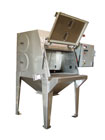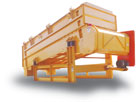
A new vibratory screener allows more usuable product to pass through the sifter, decreases waste and saves time and labor in recycling at the Deseret pasta plant. Source: Kason Corp.
When The Church of Jesus Christ of Latter-Day Saints established the Deseret pasta plant in the 1960s, the goal was to produce dried pasta for relief and humanitarian efforts. Although the plant is relatively small compared to large commercial pasta producers, each line currently has a capacity of 650 lb./hr. and total plant output exceeds 2 million lbs. of pasta annually. Meeting this quota was becoming difficult with the antiquated equipment used in the plant, so a replacement process began with the installment of two new presses and dryers.
“As we began these upgrades, we discovered we needed better refinement of our feed,” says Glade Thompson, director of maintenance at the plant. “We decided to replace the pre-war vintage gyratory sifter.”
After investigating both gyratory and vibrating screen sifters, Thompson opted for a 48-in. diameter Kason Vibroscreen circular vibratory screener that uses multi-plane inertial vibration to separate byproducts and large particles from the feed to the pasta presses.
Feed to the Deseret pasta process consists of fresh durum granular plus a small amount (1% to 4%) of re-grind – recycled pasta ground in a hammer mill to the proper size and mixed into the feed. Fresh feed is pneumatically conveyed in a 2.5-in pressurized line from two 60,000-lb. fresh silos through a dust collector and rotary airlock valve into the feed hopper. Regrind is mechanically conveyed via a 4-in. diameter auger conveyor to the feed hopper. The mixture is then metered through a rotary airlock valve into the vibratory sifter at a rate of 1,800 to 2,000 lb./hr. on a continuous basis.
Sifted feed exits the screener through another rotary airlock and is pneumatically conveyed in a 2-in. line under pressure to two 1,500-lb. mixer storage tanks. From there it feeds both the short- and long-goods pasta production lines, where it is mixed with water to make dough, extruded into pasta, cut to the proper size and dried. Material screened from the feed exits the screener’s discharge spout into a box and is manually recycled into the feed hopper.
The durum wheat granular used at the Deseret plant has a particle size distribution range of #100-#30 mesh US sieve. It is fairly consistent in particle size, but irregular in shape with some particles that are oblong, broken or geometric. The material passed through the old gyrating sifter so quickly that a portion of the irregularly shaped, on-size particles were being discharged along with the oversize particles, requiring re-screening of the rejected material.
Thompson says he was looking for a sifter with more capacity and more opportunity for the product to contact the screen, plus the ability to control the flow. He chose the Vibroscreen sifter because the feed residence time can be easily adjusted by removing or adding weigh plates on the imbalanced counterweight system on the gyratory motor mounted below the unit. Greater residence time allows more usable product to pass through the sifter, decreases waste and saves time and labor in recycling. Thompson estimates the savings at about 0.5% of the feed.
For more information: Henry Alamzad,
Kason Corp.; 973-467-8140;info@kason.com

Eye on Equipment
Container dumper
Material Transfer’s Lift & Dump container dumper with the Lift & Seal system provides efficient discharge of non-free flowing powders into an existing mixer at 156 in. above floor level. The unit features a Lift & Seal system for sealed product discharge, 150-degree rotation, 304 stainless steel product contact surfaces and PLC controls. The dumper includes a custom safety-guarding package with a light curtain on the load side to protect employees and equipment. It is available with discharge heights up to 40 ft., and rotation to 180 degrees for any size drum or container.Material Transfer; 800-836-7068;www.materialtransfer.com

Weigh belt feeder
Thayer Scale’s line of low-capacity weigh belt feeders meters a variety of hard-to-handle materials, such as potato chips. Weighing is done through a low-deflection, non-wearing force measurement suspension system flexure scale that measures vertical loading and can take high load directed overloads. The scale uses counterweights to negate the tare weight of the weigh idler and the belt. One hundred percent of the scale capacity is used to weigh material, resulting in the best possible weigh signal resolution, says the company.Thayer Scale-Hyer Industries; 781-826-8101;www.thayerscale.com

Railcar connector
Cyclonaire’s railcar connector with pneumatically actuated lifters streamlines unloading dual-outlet, hopper-bottom railcars. The company says the equipment reduces the time and eliminates the spillage associated with mating railcar connectors with hopper slide gates. Pneumatic controls allow operators to elevate the material chute from between the tracks, position the adapter plates directly under each hopper slide gate and mate them firmly against the hopper gates throughout the unloading operation.Cyclonaire; 800-445-0730;www.cyclonaire.com

Powder weigher
Replacing an auger or volumetric filler with a new Ishida CG Series Cut-Gate weigher may help achieve greater fill accuracy and eliminate messy and time-consuming screw and cup changes, says Heat and Control, the manufacturer. Suitable for flowing dry, powder and granular products, the weigher requires a preset change through the control panel to run a new target weight. It is available with 1 to 10 weigh heads, can run at 15 weighments per minute per head and can be cleaned without tools.Heat and Control; 800-227-5980;www.heatandcontrol.com

Bag-break station
This bag-break station from NBE integrates manually dumped materials into all types of dry bulk material processing equipment. The hopper is 44-in. square and has a usable capacity of 4 cu. ft. The dust hood features a 42-in. shelf height. A large access opening provides a comfortable working environment for operators, says the company. A limit switch on the door activates the dust collection system when the door is opened and a removable baffle directs the airflow under the bag grate and into the 4-in. dia. dust collection port.NBE; 616-738-7248;kosullivan@nbe-inc.com
In-line sifters
Model QA24 and Model 611 in-line sifters from Great Western have received third-party verification of their conformance to BISCC standards. Features include easy access for inspection and maintenance, a pneumatic sieve-compression system and enhanced guard package for greater worker protection. The switch-operated pneumatic compression system provides continuous sieve compression during sifter operations, reducing subsequent sieve frame and gasket wear and effectively reducing downtime caused by inadequate sieve compression.Great Western Manufacturing; 913-682-2291;sifter@gwmfg.com

Size reduction
Modern Process Equipment’s Fractionizer allows for precision size reduction of thin, leafy materials such as tea leaves and spices. The design combines teeth and interlocking grooves to cut materials to a uniform size with minimal unwanted fines, says the company. Unlike traditional knife cutting machines, this unit eliminates product attrition, resulting in consistent, uniform product size results, according to the company.Modern Process Equipment; 773-254-3929;www.mpechicago.com

Vacuum conveying system
In order to eliminate dust, help improve the throughput of the process and improve end-product quality, K-Tron can supply in-line dilute-phase vacuum conveying systems for conveying through conical screen mills. This automated, in-line method of moving material through cone mills replaces manually loading the mill. The system can also be adapted to use nitrogen as the conveying gas, eliminating potential explosion risk. Depending on the mill, convey rates can be up to 6,000 lbs. per hour and convey distances up to 50 ft. The receivers are made of 316 stainless steel and are designed to meet cGMP sanitary standards, with a mirror polish, if required.K-Tron Pneumatic Conveying Systems;
856-589-0500;www.ktron.com

Dry-bulk separation
The Texas Shaker straight-line screening system features a multiple-deck, bulk-handling equipment design that delivers significant installed cost savings per ton-hour of capacity, says the manufacturer, Screening Strategies, a division of Triple/S Dynamics. It uses a straight-line inertia force generated by the spinning rotor, which improves shaker system balance as well as speed and amplitude. The vibration is generated by a pair of rotating, unbalanced shafts coupled with a pair of gears, resulting in uniform screening action over the entire flat surface area, says the company. A range of capacities, sizes, speeds, amplitudes, pitches and slopes are available.Triple/S Dynamics; 800-527-2116;www.sssdynamics.com